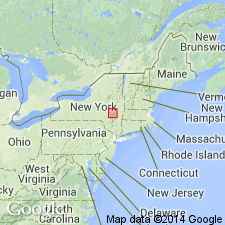
- Usage in publication:
-
- Ellenville Tongue*
- Modifications:
-
- Named
- Dominant lithology:
-
- Quartzite
- Conglomerate
- Siltstone
- AAPG geologic province:
-
- Appalachian basin
Summary:
Named the Ellenville Tongue of the Shawangunk Formation for Ellenville, Ulster Co., NY. Consists of medium-dark-gray to light-gray, medium- to thick-bedded, planar-bedded and cross-bedded, fine- to medium-grained quartzite, conglomerate, and minor red and greenish-gray shaly siltstone. Conglomerates are polymictic, with quartz, jasper, chert, and argillite pebbles. The lower contact of the Ellenville is gradational with the Wurtsboro Tongue of the Bloomsburg Red Beds and is placed at the top of a red siltstone bed in the Wurtsboro. The upper contact with the Basher Kill Tongue of the Bloomsburg Red Beds is not exposed. Thickness of the Ellenville Tongue ranges from a feather edge in northwestern NJ to as much as possibly 900 ft in the Delaware Aqueduct, although the section may be repeated by faulting. The unit is 500 ft thick at Ellenville, NY. The Ellenville Tongue is of Middle Silurian age.
Source: GNU records (USGS DDS-6; Reston GNULEX).
For more information, please contact Nancy Stamm, Geologic Names Committee Secretary.
Asterisk (*) indicates published by U.S. Geological Survey authors.
"No current usage" (†) implies that a name has been abandoned or has fallen into disuse. Former usage and, if known, replacement name given in parentheses ( ).
Slash (/) indicates name conflicts with nomenclatural guidelines (CSN, 1933; ACSN, 1961, 1970; NACSN, 1983, 2005, 2021). May be explained within brackets ([ ]).

